Orchard
The Fair Oaks Horticulture Center (FOHC) orchard was established in 1998 to demonstrate planting and pruning techniques for fruit trees that are appropriate for small urban yards. A drip irrigation system was installed, and the initial layer of mulch was applied. In 2004, the drip system was replaced with micro-sprinklers to provide adjustable water distribution, and better accessibility for cleaning and repairs.
The orchard displays many ways (shown below) to maximize the number of fruit varieties that can be planted in a small space for a long harvest period.
Many of the original trees have been removed and replaced. Some declined from disease or borers, some produced only fair tasting fruit, and some were planted too close together. These changes have been a learning experience for both the Master Gardeners and the public. Replacement trees have provided an opportunity to demonstrate the planting and training of young trees, and to taste new varieties.
Visit us during a FOHC event to see for yourself how you can successfully grow and enjoy a wide variety of delicious fruit from your own trees.
Quick links
Fruit bushes | Fig trio | "Beneficial" container | Four in a hole | Espalier | Hybrids
Hedgerow | Dwarf citrus | Genetic dwarfs | Disease resistant | Grafted apple
Grafted cherry | Brown rot resistance | Open center | Tropicals/Exotics
Fruit bushes
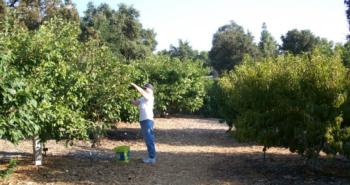
The benefits of keeping trees this small:
- Minimizes the need to climb ladders
- Keeps fruit reachable from the ground
- Allows space for a wider variety of fruit and a longer harvest season
Fruit bush trees can be grown singly, two in a hole, three in a hole, four in a hole, or in a hedgerow. There are examples of these below.
The key to fruit bush training is pruning in May, and again after harvest. Vigorous trees may need a third pruning in late summer.
Summer pruning has two main objectives:
- Control tree size: Prune out new vigorous upright shoots to keep the tree height to the desired level.
- Open up canopy: Thin out crowded new shoots allowing more light penetration into the interior of the canopy which helps develop flower buds for next year’s fruit.
Summer pruning helps to:
- Slow down the growth of a vigorous tree by reducing foliage.
- Develop structure on a new tree faster by starting structural training in the first summer instead of waiting until winter.
Avoid severe cuts that will expose fruit or large sections of bark to the hot sun. If that does happen, paint exposed branches with a 50/50 mixture of white interior latex paint and water to prevent sunburn.
Fruit bushes planted singly
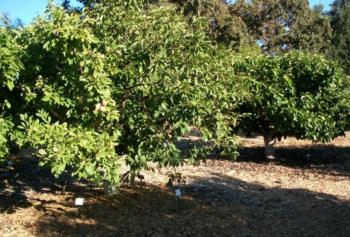
Multi-grafted trees can pose a challenge to keep vigorous varieties from crowding out a neighboring variety. Prune each grafted variety to stay within its allotted space. For a four-way grafted tree, envision that the space around the tree is divided up into four equal quadrants. Keep each variety pruned to stay within its allotted space.
Fruit bushes two in a hole
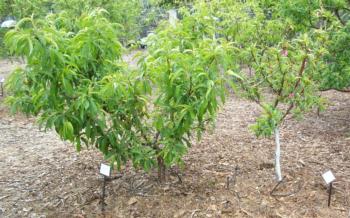
When pruning, visualize the two trees as sharing the space of one tree. It is helpful to keep the center area between the trees open so that you can stand in the middle and prune out branches reaching inward.
When planting trees this close together, it is a good idea to choose trees with similar growth rates and similar maintenance needs. These two trees, a peach and a nectarine, both require spraying for control of Peach Leaf Curl.
Fruit bushes three in a hole
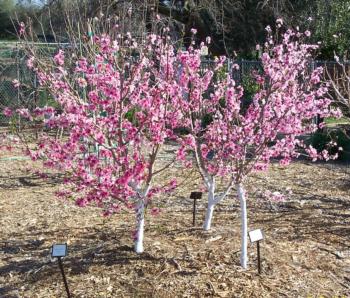
These trees were planted on a mound originally about twice the height you see today to encourage good drainage. Over the years the mound has settled but is still higher than the surrounding ground.
The original soil in this orchard was heavy clay over hardpan (a dense, almost cement-like clay layer) which prevented water from draining properly. Planting trees on mounds or berms is a good method to improve drainage in problem areas.
Fig trio
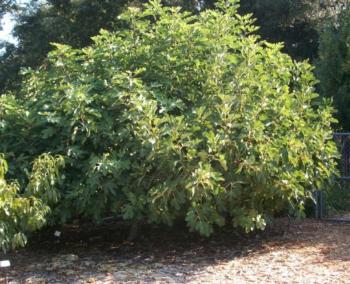
Some fig varieties have two crops a year! Tiny figs begin forming by fall, they can easily be seen during winter, and ripen early the next summer. A larger crop forms on current season’s growth and ripens late August thru October. The three varieties here (Black Mission, Kadota, Flanders) each have two crops a year.
Figs are very vigorous growers but take well to severe pruning. Winter pruning may remove part or the entire early crop. Summer pruning may reduce the fall crop. Whenever you choose to prune (winter, summer, or both), be vigilant in keeping the height down unless you want a very large tree!
“Beneficial” container garden
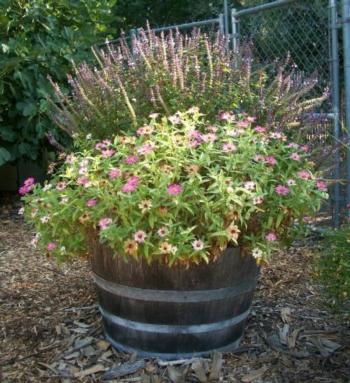
This shows some types of landscape plants that attract beneficial insects to the yard. Some beneficial insects help pollinate fruit trees; others help kill or control “bad bugs” in the yard.
For more information about plants that attract beneficial insects, see:
Attracting Beneficial Insects to Your Garden (Garden Notes 129).
Four in a hole
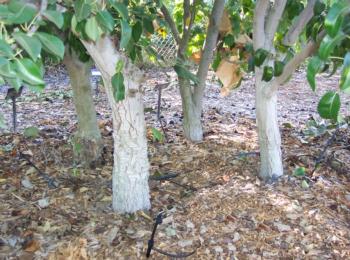
This grouping is a good example of trees which grow well together: an apple, Asian pear, and two European pears. They are compatible because:
- They have similar growth patterns without one tree being more vigorous than the others.
- They all are subject to damage from the codling moth larvae, so spraying all four trees is done at the same time.
Espalier trees
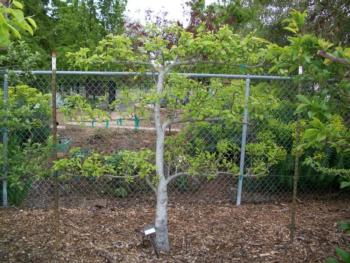
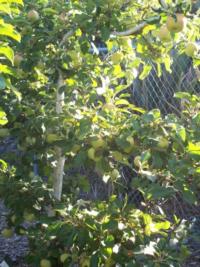
Apple espalier
|
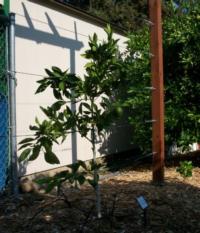
Citrus espalier
|
Apples, pears, and citrus have traditionally been espaliered. At the end of this espalier row is a dwarf pomegranate being trained in a fan shape.
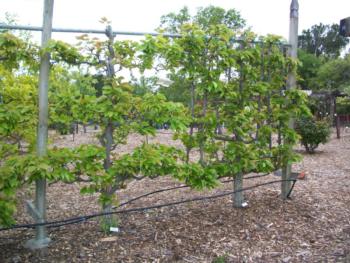
Hybrid trees

We are using summer pruning to get a head start on training this young peacotum in its first summer season. Early training helps accelerate the production of fruit. We are using the following guidelines:
- In late April, begin training the tree to an open center system where the center of the tree is kept free of large branches and shoots.
- Select three or four shoots that will become the main structural branches. These shoots ideally should be spaced several inches apart vertically, and be evenly spaced around the trunk. If selected shoots are vigorous, head them back to 2 to 2½ feet in late May or early June (or when growth is long enough) to promote side branching.
- Pinch or head back all other strong upright shoots to 4 to 6 inches.
- If the tree grows poorly the first year, severely head back primary shoots in winter to three to four buds to promote vigorous growth next year.
For more information see: Fruit Trees: Training and Pruning Deciduous Trees (ANR 8057).
Hedgerow
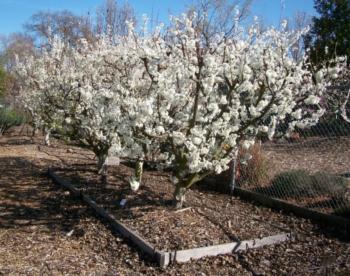
Pluots (and plums) are very vigorous growers even with summer pruning! We prune them three times during the summer.
- First pruning is in late April or early May when we remove the new vigorous upright shoots at the top of the tree to keep the tree height down. We selectively remove upright shoots from the center of the tree to allow dappled sunlight to reach branches where fruit buds will be encouraged to form.
Finally, we prune as needed to keep the sides of the trees trimmed back from the fence and walkways.
- Second pruning is after harvest in July or early August to thin the canopy, reduce the height again, and continue to allow dappled sun into the interior of the tree.
- Third pruning is in September.
During the dormant season, without leaves to obscure our view, we concentrate on correcting structure and removing crossing, broken, or diseased branches.
Dwarf citrus
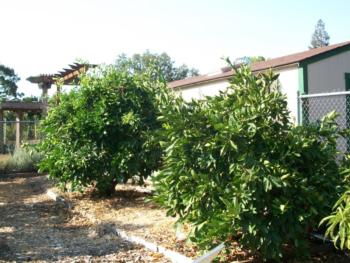
If you wish to see more citrus varieties, thirteen dwarf citrus are growing outside the main orchard along the west fence beyond the pond and vegetables.
Frost protection of citrus is a concern in the Sacramento area when selecting citrus varieties. Young citrus trees need to have some frost protection for the first 4 or 5 years. Older trees vary in their tenderness depending on the type of citrus.
Sacramento winters frequently dip just below freezing for a couple of hours at night. Occasionally the temperature drops to the mid 20s for several hours. Every seven or so years it seems an arctic cold air mass moves in. Temperatures in the low 20s for more than 6 hours a night for several days can endanger the life of susceptible varieties.
Citrus tree leaves and branches can be damaged below the temperatures shown below (these are not hard and fast figures but guidelines):
| Limes | 29° |
| Lemons and grapefruit | 26° |
| Meyer lemon | 22° |
| Oranges and mandarins | 21° |
| Kumquats | 19° |
Depending on the state of ripening, citrus fruit can be damaged below 27°.
For more information on frost protection and what to do during a hard freeze, see: Frost Protection for Citrus and Other Subtropicals (ANR 8100).
Genetic dwarf peaches and nectarines
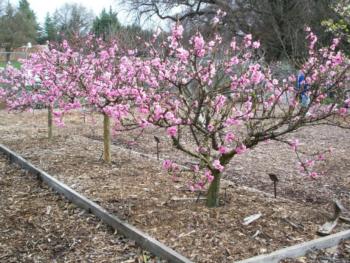
This is a row of two genetic dwarf peaches and a genetic dwarf nectarine.
How is a “semi-dwarf” peach (or nectarine) tree different from a “genetic dwarf” tree?
- A semi-dwarf peach tree is composed of a standard fruit variety grafted onto dwarfing rootstock. It is the rootstock that affects the overall tree size.
- A genetic dwarf peach is a variety that has been bred to include a dwarfing gene, producing a naturally small-growing tree. It is usually grafted onto a standard rootstock; it is not the rootstock that affects the tree size.
Observe how short the internodes are—the section of stem between two leaf buds (nodes). This results in compact branches and dense foliage.
Standard varieties of peaches and nectarines are not available in genetic dwarf, but some delicious and productive genetic dwarf varieties are available at nurseries.
Because fruit set can far exceed the small canopy’s capacity to grow large fruit, the home gardener must be careful to thin dwarf tree fruit properly. Not only will proper fruit thinning increase fruit size, but can prevent branches from breaking.
Lower-vigor dwarf trees require more care, such as frequent irrigations, careful pruning to thin out dense foliage, and regular fertilizing. Dwarf trees do not usually benefit from summer pruning.
Peach and nectarine trees with disease resistance to peach leaf curl
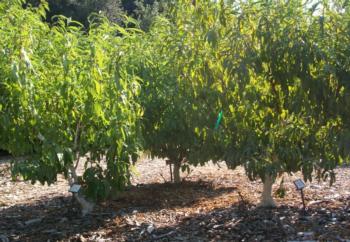
Peach leaf curl is a very common fungal disease on peach and nectarine trees in the Sacramento area. Two products commonly used in the past to control this disease, tri-basic copper sulfate (a blue powder), and lime-sulfur are no longer available to the homeowner. Liquid copper sprays are still available, however, they are not as effective as the discontinued items.
For the most recent information on peach leaf curl, refer to Peach Leaf Curl (Pest Note 7426) or available from the Master Gardeners in the orchard.
Some of the new hybrid peach varieties that are resistant, or partially resistant to leaf curl are Frost, Indian Free, Muir, and Q-1-8. It has been reported that Redhaven peach and most cultivars derived from it are tolerant of leaf curl. A resistant nectarine hybrid is Kreibich.
Grafted central leader apple
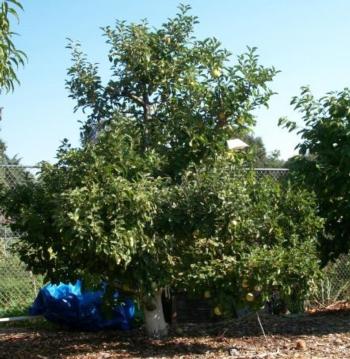
Notice that the branches that radiate out from the central trunk are not directly above the branches below them, but are offset a bit. Offset branches were purposely selected while the tree’s structure was being trained to minimize shading below. Some sunlight is needed on the branches to help develop fruit buds for fruit development the following year.
Also notice that each layer of branches is shorter than the layer beneath it. This creates the pyramidal shape like a Christmas tree. This shape also helps prevent excess shading below.
Grafted cherry
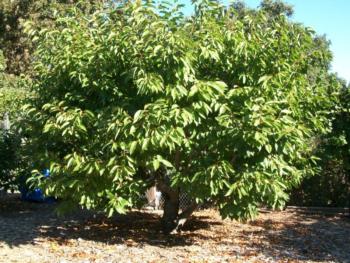
A few cherry varieties are “self-fruitful” which means no pollinizer tree is needed. Some common self-fruitful sweet cherry varieties are:
| Craig's Crimson |
| Lapins |
| Stella |
| Sunburst |
Brown rot resistance
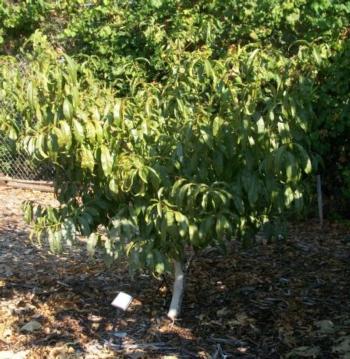
Brown rot appears as light brown soft areas on the ripening fruit, followed by powdery looking spores. At harvest, picked fruit may appear healthy, but then develop brown rot shortly after. There is more information on managing brown rot at the UC Statewide Integrated Pest Management Online site.
Open Center Training
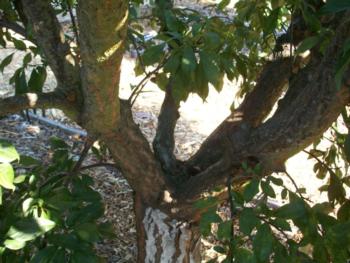
The open center system works well for peach, nectarine, pear, plum, apricot, and cherry trees. To create an open center tree:
- Immediately after planting a bare-root tree, cut off the top of the tree to about 18 to 24 inches from the ground.
- During the next year (including the first summer) select three or four scaffold branches that emerge at wide crotch angles from the main trunk. Ideally, the branches are evenly spaced around the center, and are also spaced apart vertically by several inches.
- During the life of the tree, the center is kept open with just a few small shoots providing shade and fruit in the center.
Tropical and Exotic Fruit Trees
In recent years we have added several varieties of tropical and exotic fruit trees. We recently replaced the genetic dwarf peaches/nectarines with a row of avocados (2024), two Pawpaws in a shared barrel (2018), a south African Guava in a barrel (2017), and an African Pride Atemoya in a barrel (2017).
Go to the Fruit and citrus resources page for lots more orchard fruit information.
For more information on training fruit trees, see
- Fruit Trees: Planting and Care of Young Trees (ANR 8048)
- Fruit Trees: Training and Pruning Deciduous Trees (ANR 8057)
Other useful fruit tree publications:
- Fruit Trees: Thinning Young Fruit (ANR 8047)
- Frost Protection for Citrus and Other Subtropicals (ANR 8100)
- Codling Moth (Pest Note 7412)
- Peach Leaf Curl (Pest Note 7426)
ANR publications are available at anrcatalog.ucdavis.edu
Pest Notes are available at ipm.ucdavis.edu




